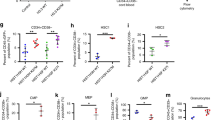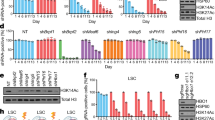Abstract
Histone deacetylase inhibitors (HDIs) are a new class of drugs with significant antileukemic activity. To explore mechanisms of disease-specific HDI activity in acute myeloid leukaemia (AML), we have characterised expression of all 18 members of the histone deacetylase family in primary AML blasts and in four control cell types, namely CD34+ progenitors from umbilical cord, either quiescent or cycling (post-culture), cycling CD34+ progenitors from GCSF-stimulated adult donors and peripheral blood mononuclear cells. Only SIRT1 was consistently overexpressed (>2 fold) in AML samples compared with all controls, while HDAC6 was overexpressed relative to adult, but not neo-natal cells. HDAC5 and SIRT4 were consistently underexpressed. AML blasts and cell lines, exposed to HDIs in culture, showed both histone hyperacetylation and, unexpectedly, specific hypermethylation of H3 lysine 4. Such treatment also modulated the pattern of HDAC expression, with strong induction of HDAC11 in all myeloid cells tested and with all inhibitors (valproate, butyrate, TSA, SAHA), and lesser, more selective, induction of HDAC9 and SIRT4. The distinct pattern of HDAC expression in AML and its response to HDIs is of relevance to the development of HDI-based therapeutic strategies and may contribute to observed patterns of clinical response and development of drug resistance.
This is a preview of subscription content, access via your institution
Access options
Subscribe to this journal
Receive 12 print issues and online access
$259.00 per year
only $21.58 per issue
Buy this article
- Purchase on Springer Link
- Instant access to full article PDF
Prices may be subject to local taxes which are calculated during checkout






Similar content being viewed by others
References
Moe-Behrens GH, Pandolfi PP . Targeting aberrant transcriptional repression in acute myeloid leukaemia. Rev Clin Exp Hematol 2003; 7: 139–159.
Faretta M, Di Croce L, Pellici PG . Effects of the acute myeloid leukaemia-associated fusion proteins on nuclear architecture. Semin Haematol 2001; 38: 42–53.
Melnick A, Licht JD . Histone deactylases as therapeutic targets in hematologic malignancies. Curr Opin Hematol 2002; 9: 322–332.
De Ruijter AJM, Van Gennip AH, Caron HN, Kemp S, Van Kuilenburg ABP . Histone deacetylases (HDACs): characterization of the classical HDAC family. Biochem J 2003; 370: 737–749.
Gregoretti IV, Lee Y-M, Goodson HV . Molecular evolution of the histone deacetylase family: functional implications of phylogenetic analysis. J Mol Biol 2004; 338: 17–31.
Blander G, Guarente L . The Sir2 family of protein deacetylases. Annu Rev Biochem 2004; 73: 417–435.
Gao L, Cueto MA, Asselbergs F, Atadja P . Cloning and functional characterisation of HDAC11, a novel member of the human histone deacetylase family. J Biol Chem 2002; 277: 25748–25755.
Sengupta S, Seto E . Regulation of histone deacetylase activities. J Cell Biochem 2004; 93: 57–67.
Matsuyama A, Shimazu T, Sumida Y, Saito A, Yoshimatsu Y, Seigneurin-Berny D et al. In vivo destabilization of dynamic microtubules by HDAC6 mediated deacetylation. EMBO J 2002; 21: 6820–6831.
Langley E, Pearson M, Faretta M, Bauer UM, Frye RA, Minucci S et al. Human SIR2 deacetylates p53 and antagonizes PML/p53-induced cellular senescence. EMBO J 2002; 21: 2383–2396.
Luo J, Nikolaev AY, Imai S, Chen D, Su F, Shiloh A et al. Negative control of p53 by Sir2 promotes cell survival under stress. Cell 2001; 107: 137–148.
Vaziri H, Dessain SK, Ng EE, Imai SI, Frye RA, Pandita TK et al. hSIR2SIRT1 functions as an NAD-dependent p53 deacetylase. Cell 2002; 107: 149–159.
Brunet A, Sweeney LB, Sturgill JF, Chua KF, Greer PL, Lin Y et al. Stress-dependent regulation of FOXO transcription factors by the SIRT1 deacetylase. Science 2004; 303: 2011–2105.
Motta MC, Divecha N, Lemieux M, Kamel C, Chen D, Gu W et al. Mammalian SIRT1 represses forkhead transcription factors. Cell 2004; 116: 551–563.
Marks PA, Richon VM, Miller T, Kelly WK . Histone deacetylase inhibitors. Adv Cancer Res 2004; 91: 137–168.
Kelly WK, O’Connor OA, Marks PA . Histone deacetylase inhibitors: from target to clinical trials. Expert Opin Investig Drugs 2002; 11: 1695–1713.
Barlow AL, van Drunen CM, Johnson CA, Tweedie S, Bird A, Turner BM . dSIR2 and dHDAC6: two novel, inhibitor resistant deacetylases in Drosophila melanogaster. Exp Cell Res 2001; 265: 90–103.
Gottlicher M, Minucci S, Zhu P, Kramer OH, Schimpf A, Giavara S et al. Valproic acid defines a novel class of HDAC inhibitors inducing differentiation of transformed cells. EMBO J 2001; 20: 6969–6978.
Turner BM, O’Neill LP, Allan IM . Histone H4 acetylation in human cells. Frequency of acetylation at different sites defined by immunolabeling with site specific antibodies. FEBS Lett 1989; 253: 141–145.
White DA, Belyaev ND, Turner BM . Preparation of site specific antibodies to acetylated histones. Methods 1999; 19: 417–424.
Johnson CA, White DA, Lavender JS, O’Neill LP, Turner BM . Human class I histone deacetylase complexes show enhanced catalytic activity in the presence of ATP and co-immunoprecipitate with the ATP-dependent chaperone protein Hsp70. J Biol Chem 2002; 277: 9590–9597.
Drexler HG, Quentmeier H, MacLeod RAF, Uphoff CC, Hu Z-B . Leukemia cell lines: in vitro models for the study of acute promyelocytic leukaemia. Leukemia Res 1995; 19: 681–691.
Kramer OH, Zhu P, Ostendorff HP, Golebiewski M, Tiefenbach J, Peters MA et al. The histone decetylase inhibitor valproic acid selectively induces proteasomal degradation of HDAC2. EMBO J 2003; 22: 3411–3420.
Whitlock JP, Galeazzi D, Schulman H . Acetylation and calcium-dependent phosphorylation of histone H3 in nuclei from butyrate-treated HeLa cells. J Biol Chem 1983; 258: 1299–1304.
Osada H, Tatematsu Y, Saito H, Yatabe Y, Mitsudomi T, Takahashi T . Reduced expression of class II histone deacetylase genes is associated with poor prognosis in lung cancer patients. Int J Cancer 2004; 112: 26–32.
Zhu P, Martin E, Mengwasser J, Schlag P, Janssen K-P, Gottlicher M . Induction of HDAC2 expression upon loss of APC in colorectal tumorigenesis. Cancer Cell 2004; 5: 455–463.
Araki T, Sasaki Y, Milbrandt J . Increased nuclear NAD biosynthesis and SIRT1 activation prevent axonal degeneration. Science 2004; 305: 1010–1013.
Cheng HL, Mostoslavsky R, Saito S, Manis JP, Gu Y, Patel P et al. Developmental defects and p53 hyperacetylation in Sir2 homolog (SIRT1)-deficient mice. Proc Natl Acad Sci USA 2003; 100: 10794–10799.
Fulco M, Schlitz RL, Iezzi S, King MT, Zhao P, Kishiwaya Y et al. Sir2 regulates skeletal muscle differentiation as a potential sensor of the redox state. Mol Cell 2003; 12: 51–62.
Cohen HY, Miller C, Bitterman KJ, Wall NR, Hekking B, Kessler B et al. Calorie restriction promotes mammalian cell survival by inducing the SIRT1 deacetylase. Science 2004; 305: 390–396.
Lachner M, O’Sullivan RJ, Jenuwein TJ . An epigenetic road map for histone lysine methylation. J Cell Sci 2003; 116: 2117–2124.
Milne TA, Briggs SD, Brock HW, Martin ME, Gibbs D, Allis CD et al. MLL targets SET domain methyltransferase activity to HOX gene promoters. Mol Cell 2002; 10: 1107–1117.
Van Lint C, Emiliani S, Verdin E . The expression of a small fraction of cellular gene is changed in response to histone hyperacetylation. Gene Exp 1996; 5: 245–254.
Suzuki H, Gabrielson E, Chen W, Anbazhagan R, van Engeland M, Weijenberg MP et al. A genomic screen for genes upregulated by demethylation and histone deacetylase inhibition in human colorectal cancer. Nat Genet 2002; 31: 141–149.
Peart MJ, Smyth GK, van Laar RK, Bowtell DD, Richon VM, Marks PA et al. Identification and functional significance of genes regulated by structurally different histone deacetylase inhibitors. Proc Natl Acad Sci USA 2005; 102: 3697–3702.
Kyrylenko S, Kyrylenko O, Suuronen T, Salminen A . Differential regulation of the Sir2 histone deacetylase genes by inhibitors of class I and II histone deacetylases. Cell Mol Life Sci 2003; 60: 1990–1997.
Acknowledgements
We thank Professor Paul Marks and Dr Victoria Richon (Aton Pharma Inc., New York) for generous provision of SAHA, Dorothy McDonald and Virginia Turner (National Blood Service, Birmingham) for invaluable help in the processing of primary samples, Christine James and Emma Yates for skilled technical assistance and the custodians of the National Cancer Research Network AML cell bank for access to archived material. This work was supported by the Leukaemia Research Fund (CMB, CC, BMT) and Cancer Research UK (BMT).
Author information
Authors and Affiliations
Corresponding author
Additional information
Supplementary Information
Supplementary Information accompanies the paper on the Leukemia website (http://www.nature.com/leu).
Rights and permissions
About this article
Cite this article
Bradbury, C., Khanim, F., Hayden, R. et al. Histone deacetylases in acute myeloid leukaemia show a distinctive pattern of expression that changes selectively in response to deacetylase inhibitors. Leukemia 19, 1751–1759 (2005). https://doi.org/10.1038/sj.leu.2403910
Received:
Accepted:
Published:
Issue Date:
DOI: https://doi.org/10.1038/sj.leu.2403910
Keywords
This article is cited by
-
Divalproex, Valproate, & Developing Treatment Options for Cluster Headache Prophylaxis: Clinical Practice Considerations
SN Comprehensive Clinical Medicine (2024)
-
HDAC6 inhibitor ACY-1215 enhances STAT1 acetylation to block PD-L1 for colorectal cancer immunotherapy
Cancer Immunology, Immunotherapy (2024)
-
Expression Changes of SIRT1 and FOXO3a Significantly Correlate with Oxidative Stress Resistance Genes in AML Patients
Indian Journal of Hematology and Blood Transfusion (2023)
-
HDAC11 mediates the ubiquitin-dependent degradation of p53 and inhibits the anti-leukemia effect of PD0166285
Medical Oncology (2023)
-
Nucleolar protein NOC4L inhibits tumorigenesis and progression by attenuating SIRT1-mediated p53 deacetylation
Oncogene (2022)



